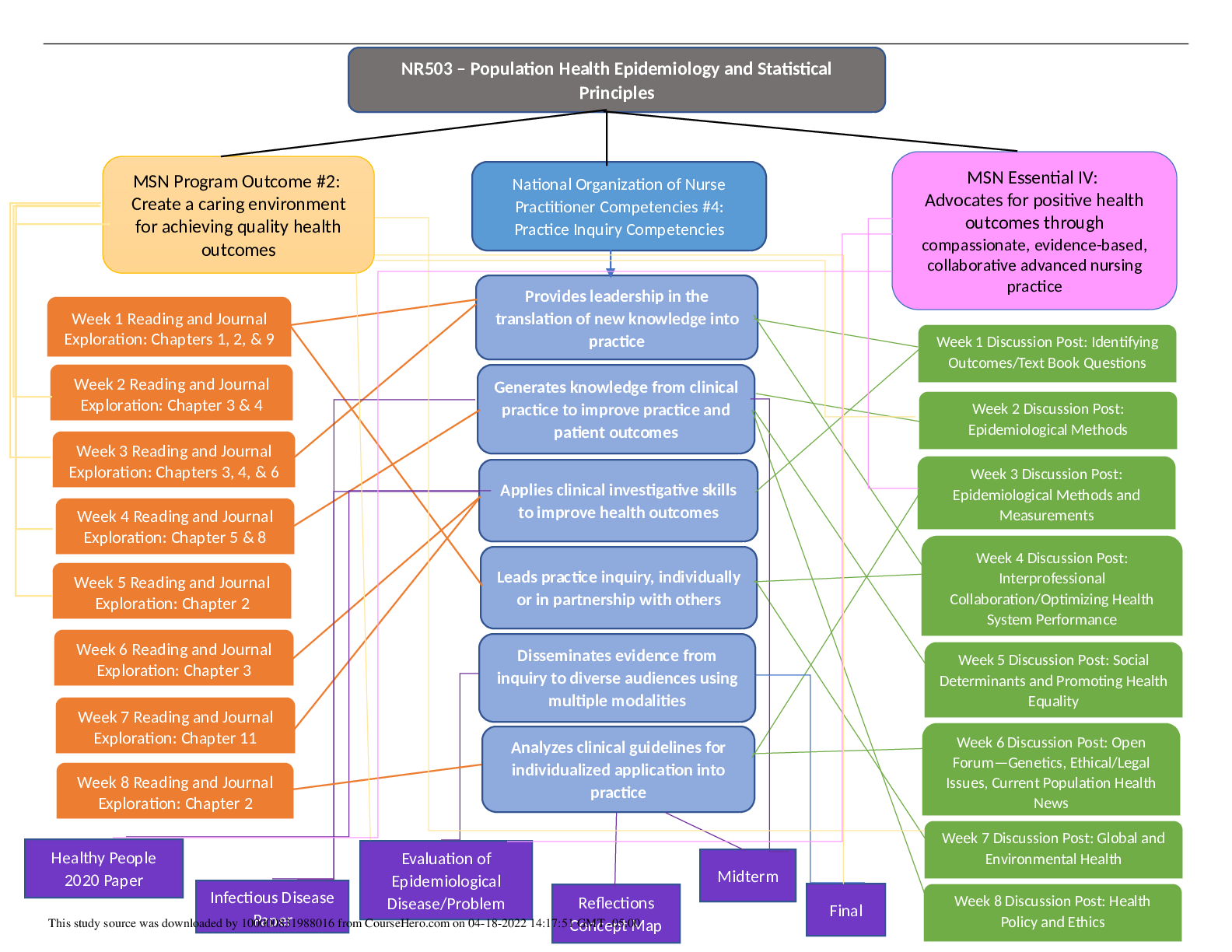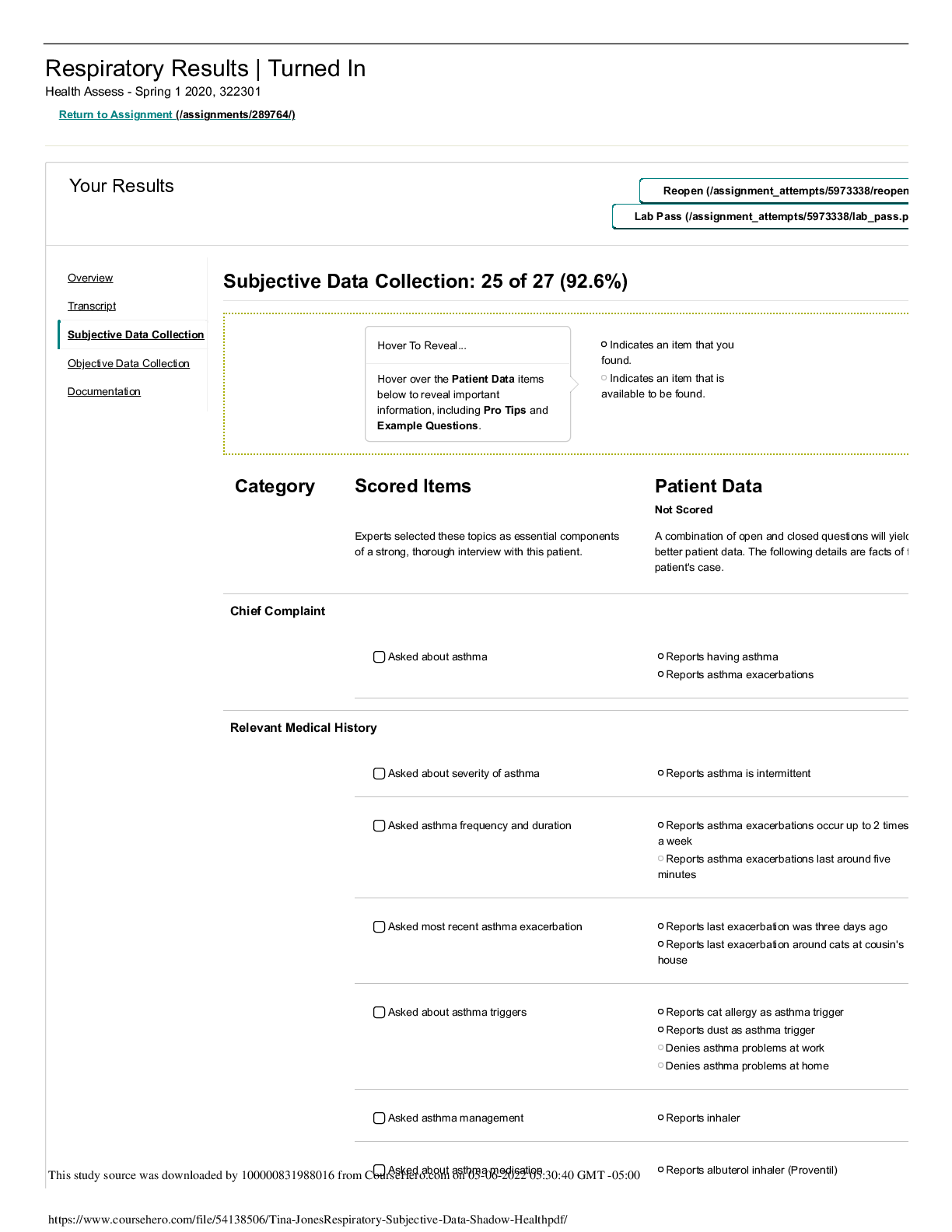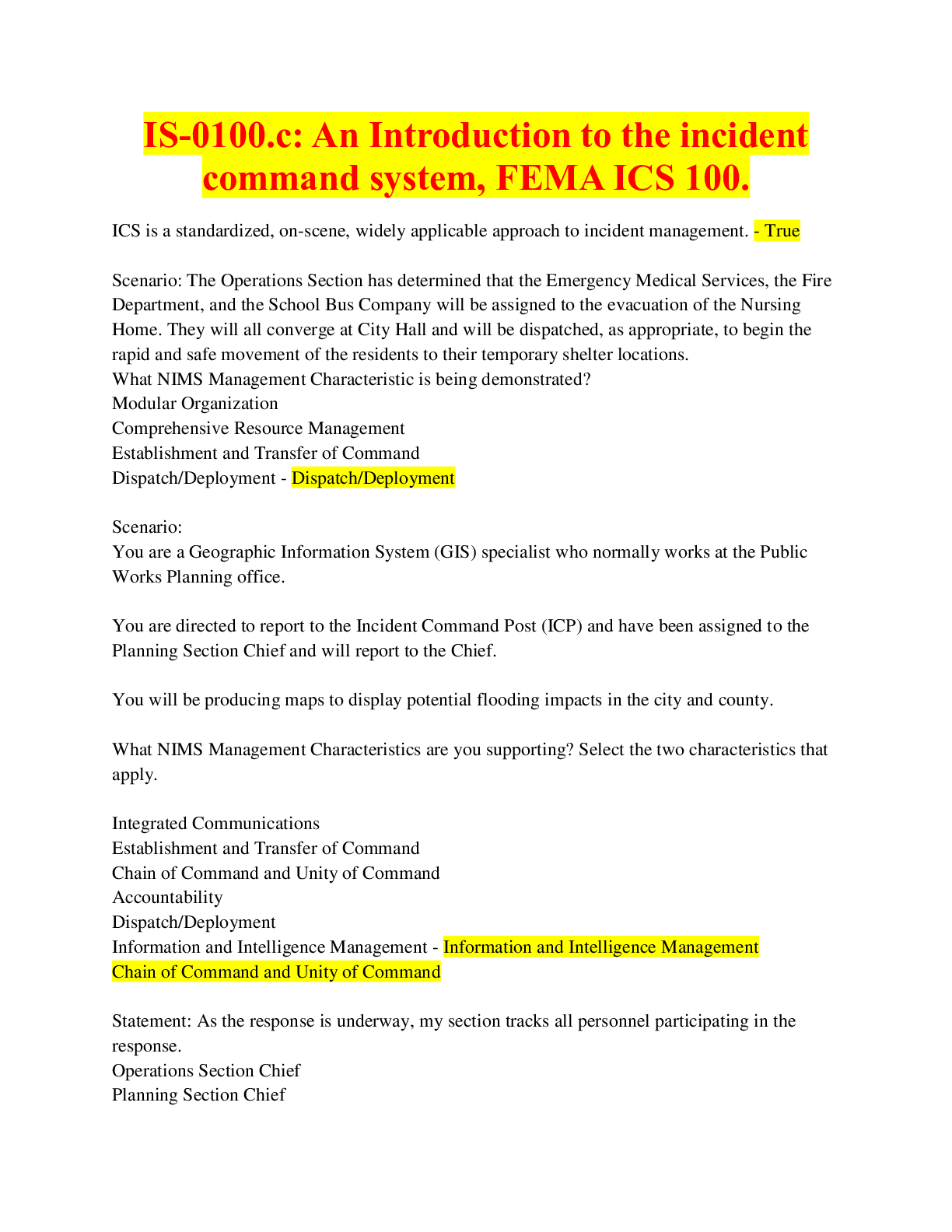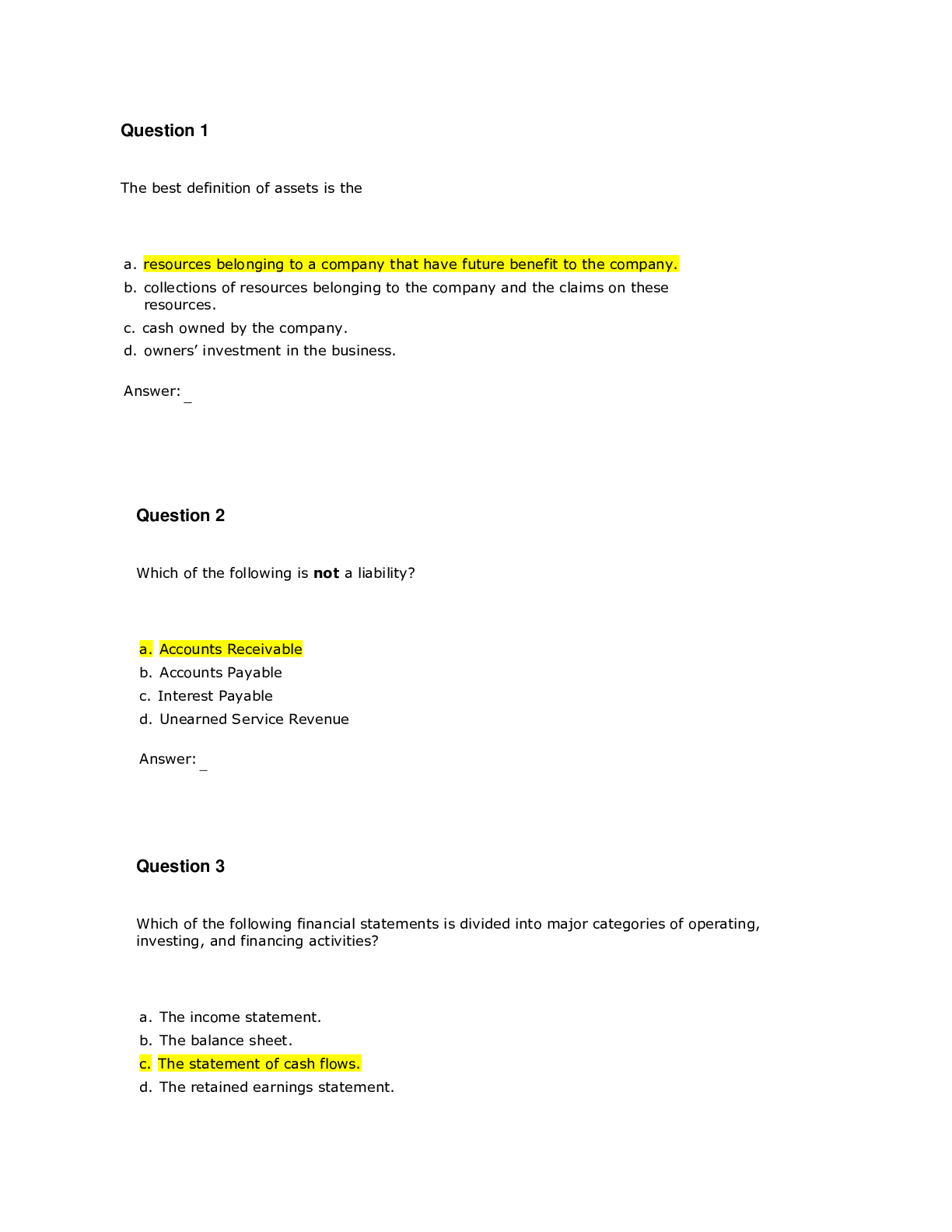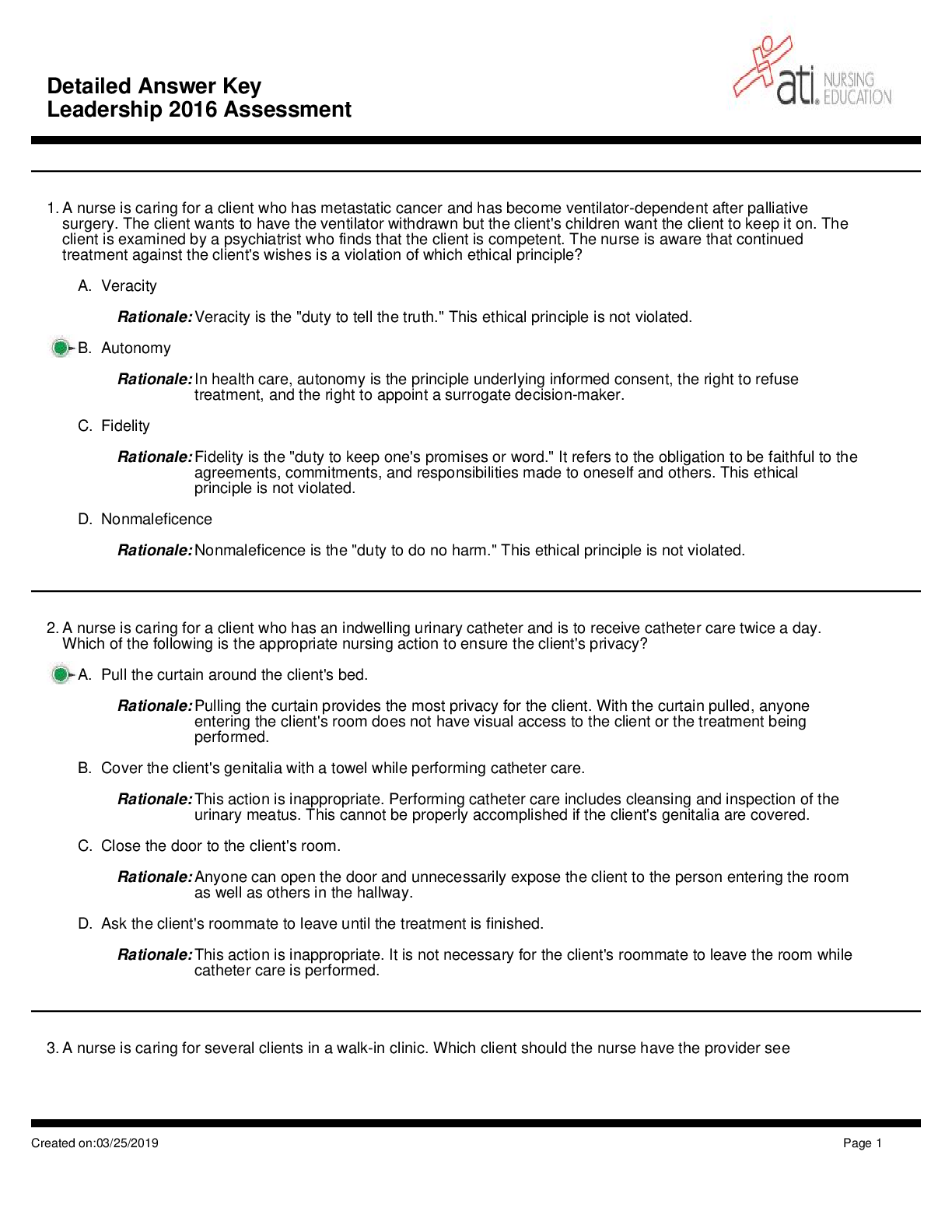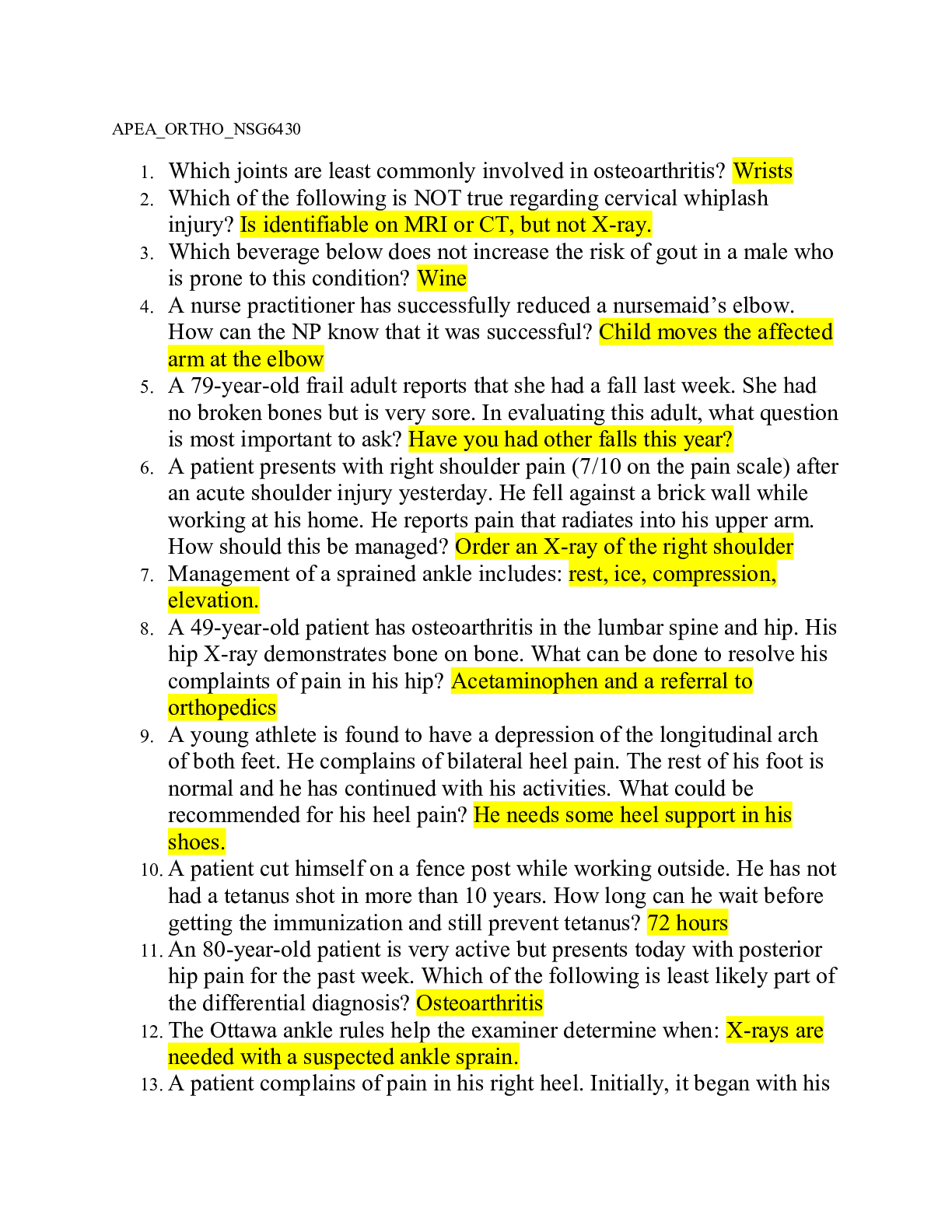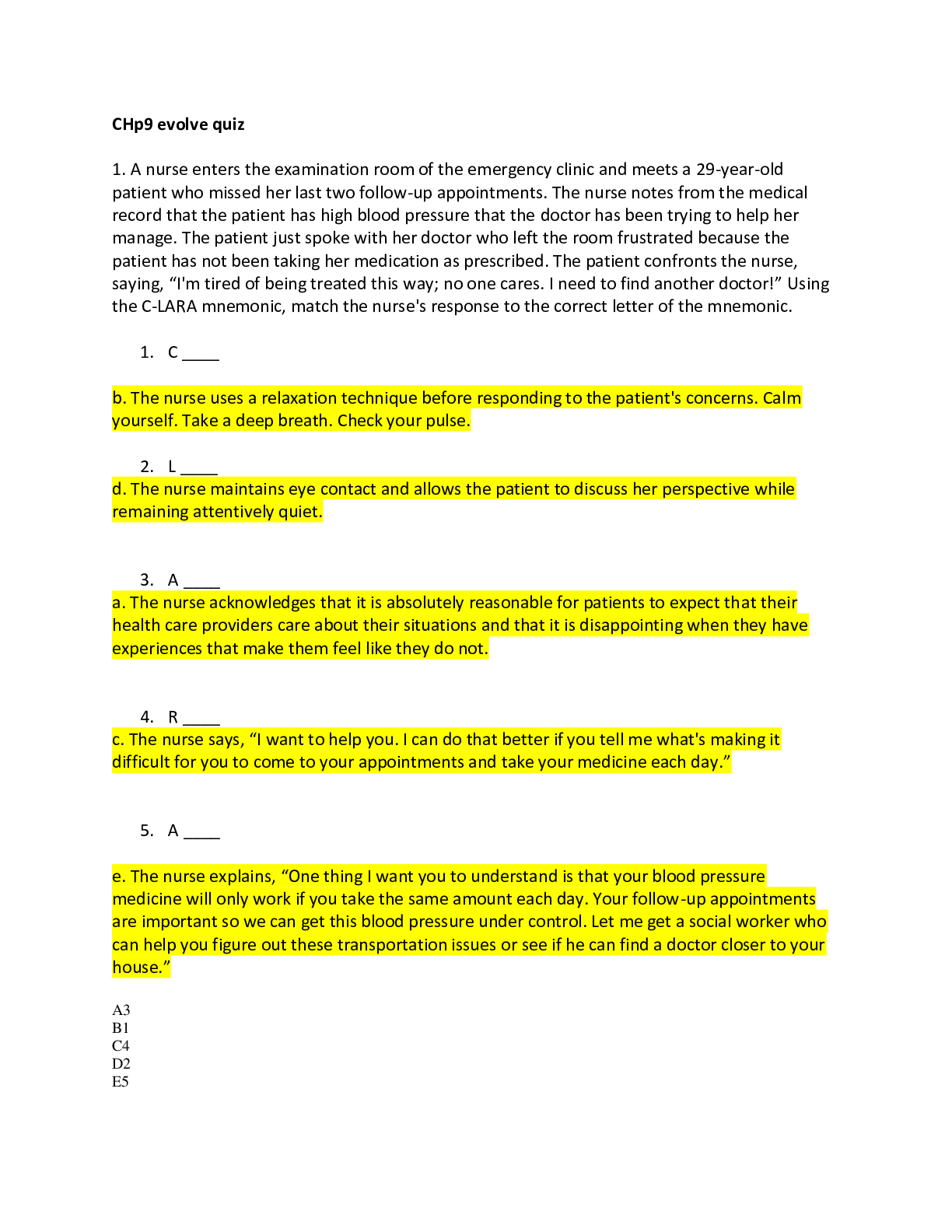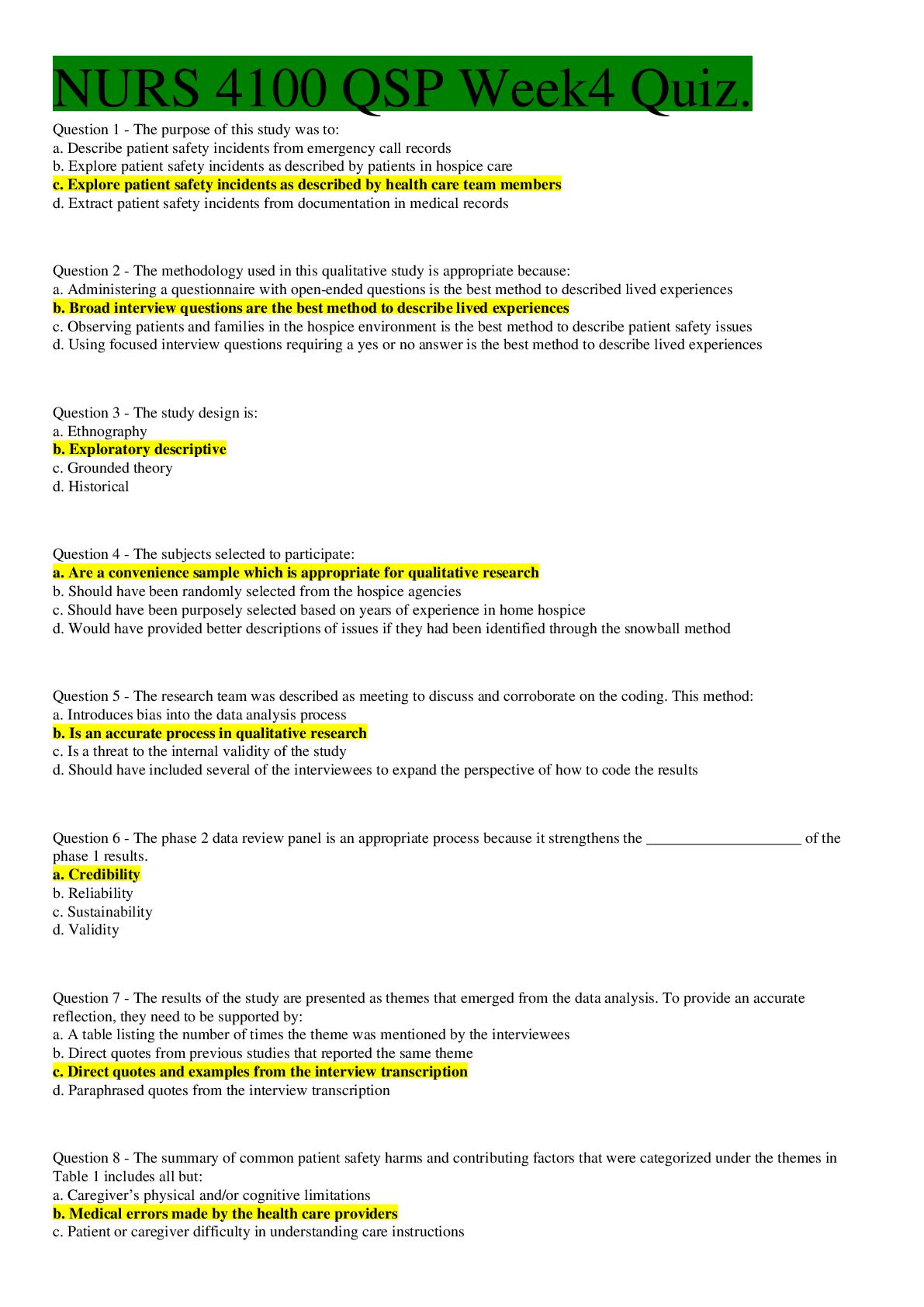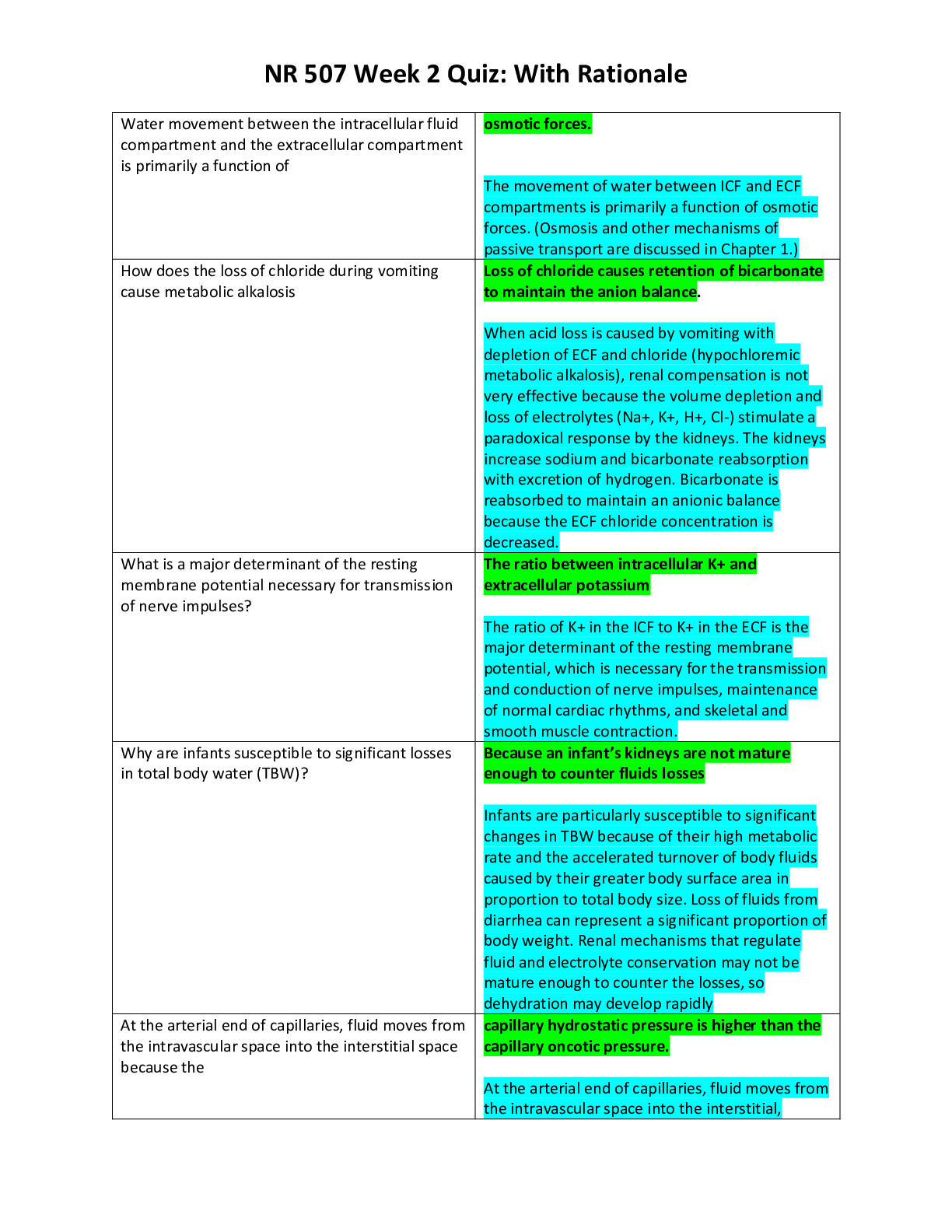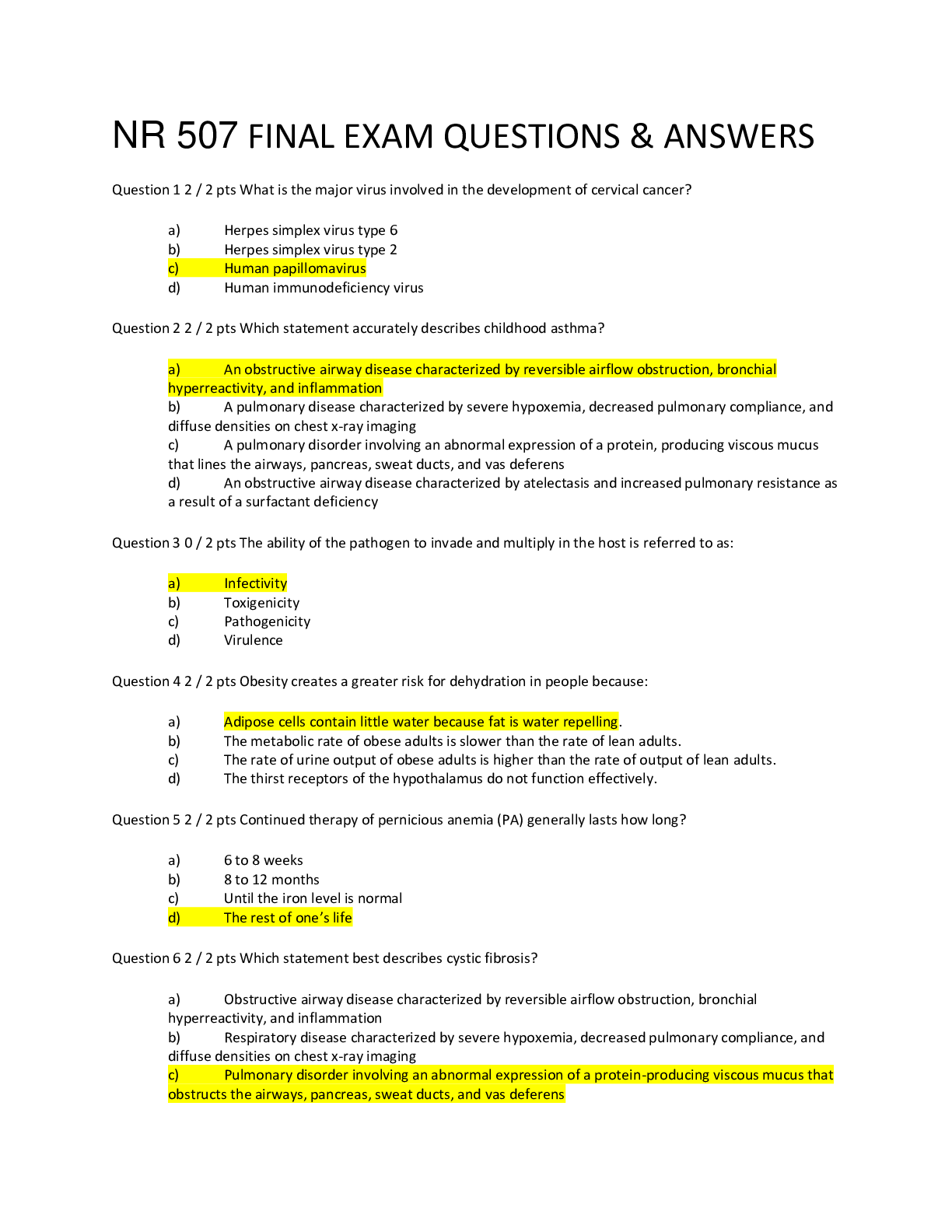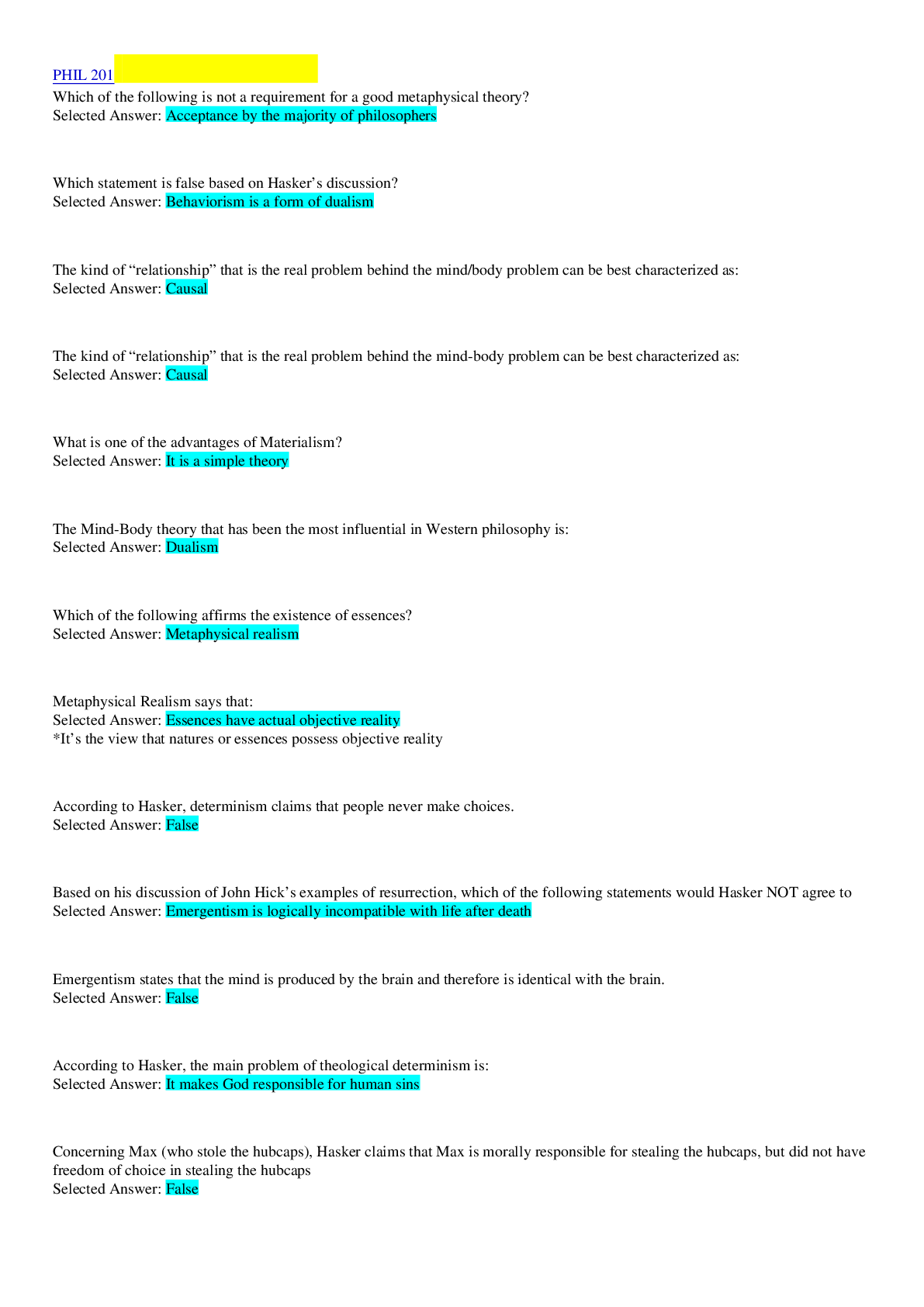NUR 141 Pharma Test 2, Questions & Answers With Rationales
Document Content and Description Below
NUR 141 Pharma Test 2, Questions & Answers With Rationales-The nurse is providing education to a client who has been scheduled to receive spinal anesthesia. What anatomical location will the nurse ide... ntify as the site of administration? A) Mucous membrane B) Epidural space C) Nerve ganglion D) Lumbar region - D) Lumbar region Rationale: Spinal anesthesia involves injecting the anesthetic agent into the cerebrospinal fluid, usually in the lumbar spine. Epidural anesthesia involves the injection of an anesthetic into the epidural space. Nerve block anesthesia blocks a group of nerves, called a plexus or ganglion, to a specific area of the body. Topical anesthesia involves the application of a local anesthetic on the skin or mucous membranes. The induction of a local anesthetic would decrease the permeability of the nerve cell membrane to which element? A) Sodium B) Glucose C) Bicarbonate D) Phosphorus - A) Sodium Rationale: Local anesthetics decrease the permeability of the nerve cell membrane to ions, especially sodium. NCLEX: What medical diagnosis is likely to be managed with the daily administration of a 5% to 20% topical benzocaine solution? A) Psoriasis B) Hemorrhoids C) Stomatitis D) Chronic pain - B) Hemorrhoids Rationale: Application of the 5% to 20% topical solution of benzocaine relieves hemorrhoid pain. This solution is not indicated in the treatment of psoriasis, chronic pain, or stomatitis. Which medication used for local and regional anesthesia has the longest duration of action? A) Mepivacaine B) Procaine C) Bupivacaine D) Lidocaine - C) Bupivacaine Rationale: Bupivacaine is used for local, regional, and spinal anesthesia for diagnostic and therapeutic procedures. The drug is more potent and has a longer duration of action than lidocaine, procaine, or mepivacaine. For what client is intravenous (IV) administration of 2% lidocaine most likely indicated? A) A client who requires a bolus of IV normal saline to restore vascular volume B) A client whose lower limb pain has not responded to opioids C) A client who is scheduled to receive an IV dose of propofol D) A client who has just had a peripherally inserted central catheter (PICC) inserted - C) A client who is scheduled to receive an IV dose of propofol Rationale: A 2% lidocaine solution may be administered intravenously preceding administration of a painful IV medication such as propofol in the surgical arena. Bolus IV fluids, recent PICC insertion, and limb pain do not warrant IV administration of lidocaine. A client with a history that suggests a possible hypersensitivity to chloroprocaine requires administration of the drug. Following administration, what assessment should the nurse prioritize? A) Musculoskeletal B) Integumentary C) Respiratory D) Neurological - C) Respiratory Rationale: Excessive doses of chloroprocaine can result in respiratory depression; respiratory assessment is consequently indicated. It is less important to assess the client's temperature, neurologic function, or musculoskeletal status. To determine therapeutic effects, it is necessary to assess for cutaneous sensation in the client's integumentary system. A primiparous woman who has been in the first stage of labor for 2 hours will receive an anesthetic. What would the perinatal nurse anticipate being the anesthetic of choice? A) Intravenous anesthesia B) Spinal anesthesia C) Epidural anesthesia D) Topical anesthesia - C) Epidural anesthesia Rationale: Epidural anesthesia involves injecting the anesthetic into the epidural space. It is used most often in obstetrics during labor and birth. Topical, intravenous, and spinal anesthesia are unlikely choices for this client. The nurse is providing education to a client who will receive an injection of chloroprocaine. The nurse should instruct the client that sensation is likely to return how long after the injection? A) 60 minutes B) 10 minutes C) 20 minutes D) 3 hours - A) 60 minutes Rationale: Chloroprocaine is absorbed rapidly at the injection site. The onset of action is 6 to 12 minutes, with a duration of 1 hour. The nurse has just completed administration of an oral local anesthetic mouthwash to a client. What undesired outcome is the nurse preventing by withholding food and fluids following administration? A) Gastroesophageal reflux B) Dysphagia C) Gastritis D) Aspiration - D) Aspiration Rationale: Clients should not drink fluids or eat after gargling with oral anesthetics due to the risk of aspiration. This intervention does not prevent gastritis, reflux, or dysphagia. While assisting the health care provider with a minor procedure involving a local anesthetic, the nurse monitors the client for a systemic toxicity event. What is the usual trigger for such an event? A) A genetic predisposition toward incomplete metabolism of the anesthetic B) A type II hypersensitivity response to the anesthetic C) A type I hypersensitivity response to the anesthetic D) Systemic absorption of a local anesthetic - D) Systemic absorption of a local anesthetic Rationale: LAST occurs when the local anesthetic is absorbed systemically, resulting in extreme central nervous system (CNS) excitation followed by cardiovascular excitation and cardiovascular collapse. LAST is not a hypersensitivity reaction or a result of incomplete metabolism. A client has been prescribed oral lidocaine solution prior to a bronchoscopy. What instruction should the nurse provide? A) ''Hold this solution under your tongue for a minute before swallowing it.'' B) ''Hold this solution in your mouth for a few seconds and then spit it out.'' C) ''Swish the solution around your mouth for a few seconds and then spit it into this basin.'' D) ''Gargle with the solution for 30 seconds and then swallow it.'' - D) ''Gargle with the solution for 30 seconds and then swallow it.'' Rationale: When pharyngeal anesthesia is needed, such as prior to a bronchoscopy, the client gargles and then swallows the oral lidocaine. This process best effects the local anesthetic of the medication. The other described actions will result in a lesser anesthetic effect. The nurse is preparing to insert a peripheral intravenous catheter into a school-age client. What local anesthetic is the nurse likely to apply prior to insertion? A) Tetracaine hydrochloride B) Cocaine hydrochloride ointment C) Eutectic mixture of local anesthetics (EMLA) cream D) Benzocaine cream - C) Eutectic mixture of local anesthetics (EMLA) cream Rationale: Eutectic mixture of local anesthetics (EMLA) is a cream-based mixture of lidocaine and prilocaine applied to intact skin. The cream is applied at an injection site with an occlusive dressing at least 60 minutes before the vaccination or venipuncture. Tetracaine, cocaine, and benzocaine are not used for this purpose. A client is scheduled for a colonoscopy involving sedation with propofol. Prior to the procedure, the nurse should assess the client for what possible allergy? Select all that apply. 1) Nuts 2) Soybeans 3) Shellfish 4) Eggs 5) Dairy products A) 1,2,3 B) 2,4 C) 3,5 D) 1,4 E) None are F) All are - B) 2,4 Rationale: Clients who are allergic to soybean or soy products, or eggs or egg products, should not receive propofol. Allergies involving nuts, shellfish, and dairy products are not contraindications. [Show More]
Last updated: 5 days ago
Preview 5 out of 52 pages

Loading document previews ...
Buy this document to get the full access instantly
Instant Download Access after purchase
Add to cartInstant download
We Accept:

Reviews( 0 )
$13.50
Document information
Connected school, study & course
About the document
Uploaded On
Jun 27, 2024
Number of pages
52
Written in
Additional information
This document has been written for:
Uploaded
Jun 27, 2024
Downloads
0
Views
6






